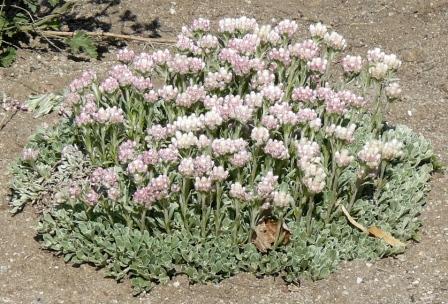Antennaria microphylla in the Landscape

Diane Jones, Draggin Wing Farm, Water-thrifty Plants for Idaho
Scientfic Name: Antennaria microphyllaCommon Name: Littleleaf Pussytoes, Rosy Pussytoes, Pink Pussytoes
Description: Very low growing, tight groundcover gives rise to pinkish "pussytoe" blossoms in spring. Spreads nicely around garden rocks and thrives in dry sunny areas with poor, well-drained soil. Retains grey-green leaves all winter.
Native Habitat: Rosy pussytoes is a hightly variable species found in dry, open habitats including plains, hills, open woods, and dry meadows throughout the Western U.S. and Canada. Hardy to zone 2.
Cultural Requirement
Soil: Well-drained, shallow, nutrient-poor or ordinary garden soil
Moisture Tolerance: Low to very low supplemental water; does well on drip
Sun/Shade/Preference: Full sun
Transplanting: Easy
Propagation: Seed, cuttings or division
Maintenance (pruning, fertilization, deadheading, division, irrigation, etc): Basal leaves tend to die back somewhat after flowering, but will regenerate by later summer. To maintain as a solid groundcover, prevent flowering by shearing off flower stalks in late spring. Needs little or no fertilization.
Insect, disease, or other problems: None of concern
Landscape Value
Use in the Landscape: Attractive evergreen groundcover. Use in low borders or xeric rock gardens.
Foliage: Spreading low mats of silver leaves are attractive all year.
Flower: Cute little "pussytoes" in shades of white or pink.
Timing: Mid May-Mid June
Color: shades of white, pink, red or purple
Fruit: The fruit is an achene 0.03 to 0.05 inch long
Form: Spreading mat
Texture: Dense
Ultimate Size: One inch by variable width
Rate of Growth: Moderate growth with supplemental water
Suggested Plant Partners: Woolly Sunflower, Cutleaf Daisy
Availability: Occasionally available at specialty nurseries
Cultivars: None
References:

